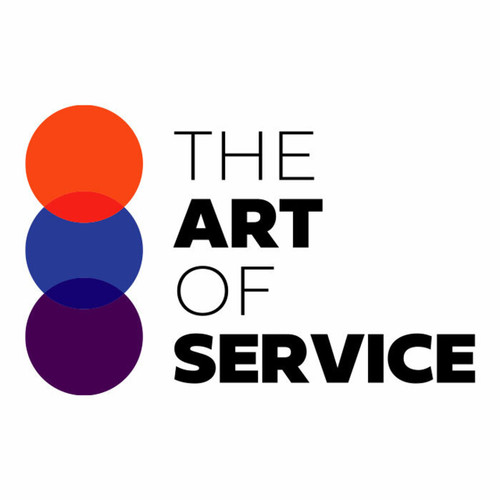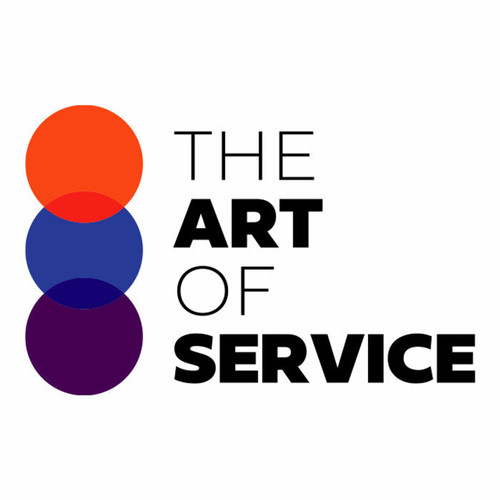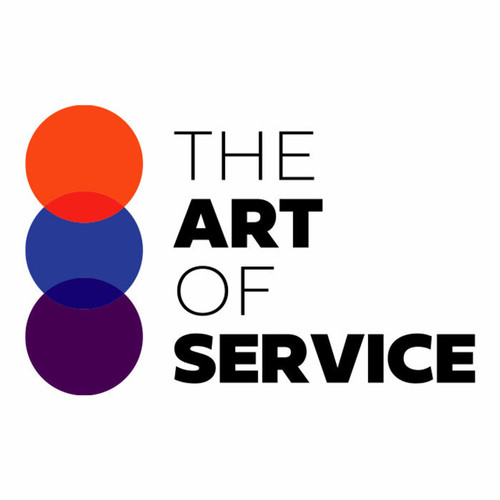This comprehensive dataset contains 1518 prioritized requirements, solutions, benefits, and results specifically targeted towards the modern workforce and the evolving landscape of automation, robotics, and virtual reality.
With the Millennial generation making up the largest demographic in the workforce, it′s crucial to understand their needs and how to harness their full potential.
Our knowledge base offers a wealth of information on how to effectively manage and engage with this tech-savvy group, ensuring a productive and innovative workforce.
But it′s not just about Millennials.
Our dataset covers a wide range of topics, from the latest technological advancements to successful case studies, all aimed at preparing businesses for the future of work.
We understand that staying ahead of the curve is essential for long-term success, and our knowledge base provides the tools to do just that.
Compared to competitors and alternative resources, our Millennial Workforce and Future of Work, How to Thrive in the Age of Automation, Robotics, and Virtual Reality Knowledge Base stands out as the most comprehensive and valuable source of information for professionals and businesses alike.
It offers a detailed product overview and specification, covering everything from DIY solutions to affordable alternatives, making it accessible to a wide audience.
Our knowledge base goes beyond just theory and provides practical and actionable insights.
With detailed case studies and use cases, you can see firsthand how others have successfully implemented and reaped the benefits of the knowledge and strategies within this dataset.
Don′t miss out on the opportunity to stay ahead of the game and adapt to the ever-changing business landscape.
Our Millennial Workforce and Future of Work, How to Thrive in the Age of Automation, Robotics, and Virtual Reality Knowledge Base is a must-have for any business looking to thrive in the digital age.
So why wait? Get your hands on this invaluable resource today!
Discover Insights, Make Informed Decisions, and Stay Ahead of the Curve:
Key Features:
Comprehensive set of 1518 prioritized Millennial Workforce requirements. - Extensive coverage of 151 Millennial Workforce topic scopes.
- In-depth analysis of 151 Millennial Workforce step-by-step solutions, benefits, BHAGs.
- Detailed examination of 151 Millennial Workforce case studies and use cases.
- Digital download upon purchase.
- Enjoy lifetime document updates included with your purchase.
- Benefit from a fully editable and customizable Excel format.
- Trusted and utilized by over 10,000 organizations.
- Covering: Video Conferencing, Remote Team Building, Co Working Spaces, Workforce Diversity, Remote Working, Work From Anywhere, Flexibility In The Workforce, Cognitive Computing, Online Collaboration Tools, Digital Transformation, Virtual Meetings, Work Life Harmony, Cloud Computing, Robotic Process Automation, Wearable Technology, Artificial Intelligence In HR, Remote Workforce Management, Digital Meetings, Robotic Workforce, Work Life Balance, Digital Onboarding, Workforce Planning In The Digital Age, Remote Access, Technological Advancements, Blockchain In Human Resources, Remote Job Opportunities, Flexible Work Environment, Human Machine Interaction, Adaptive Leadership, Employee Well Being, Digital Skills Gap, Future Workforce, Automation In Healthcare, Intelligent Automation, Future Of Work, Artificial Intelligence Ethics, Productivity Apps, Virtual Assistants, Artificial Intelligence In Education, Digital Nomads, Digital Marketing Strategies, Smart Offices, Augmented Learning, Internet Of Things, Augmented Reality Implementation, Future Of Education, Collaborative Innovation, Remote Management, Virtual Team Building, Cybersecurity Training, Remote Work Productivity, AI Powered Personalization, Distributed Teams, Global Workforce, Virtual Reality Education, Collaborative Platforms, Distributed Workforce, Digital Communication Tools, Virtual Reality Shopping, Flexible Workforce Models, New Job Roles, Virtual Training Programs, Augmented Workforce, Personalized Learning, Virtual Reality Therapy, Smart Contracts, Flexible Work Arrangements, Teleworking Solutions, Cybersecurity For Remote Work, Automation And Ethics, Future Of HR, Cybersecurity Concerns, Remote Workforce Engagement, Data Privacy, Chatbots In Customer Service, BYOD Security, Mobile Workforce, Digital Payment Methods, Smart Workforce Management, Automation In The Workplace, Robotics In Manufacturing, Workforce Analytics, Virtual Collaboration, Intelligent Assistants, Virtual Work Environment, Predictive Analytics, Cloud Computing In The Workplace, Remote Work Benefits, Digital Work Life, Artificial Intelligence, Augmented Reality Marketing, Online Platforms For Work, Millennial Workforce, Virtual Reality Training, Machine Learning Integration, Voice Recognition Technology, Collaborative Robots, Automated Supply Chain, Human Machine Collaboration, Work From Home Productivity, Remote Teams, Workplace Collaboration Tools, Innovation In The Workplace, Flexible Hours, Collaboration Tools, Data Privacy In Remote Work, 5G Technology Impact, Augmented Reality, Digital Transformation In The Workplace, Artificial Intelligence In The Workplace, Cloud Based Collaboration, Digital Skills, Automation In Customer Service, Data Analytics For Workforce Management, Collaboration In The Cloud, Augmented Reality Advertising, Remote Work Strategies, Remote Work Best Practices, Telecommuting Benefits, Digital Workplace Culture, Learning Platforms, Collaborative Spaces, Smart Homes, Data Driven Decision Making, Workforce Mobility, Workplace Wellness, Digital Branding, Flexible Work Schedule, Remote Work Challenges, Automation Impact, Gig Economy, Transparency In Automated Decision Making, Productivity Hacks, Hybrid Workforce, Smart Cities, Automation Testing, Virtual Team Communication, Smart Office Spaces, Digital Disruption, Work Life Integration, Smart Buildings, Work And Technology Integration, Gamification In The Workplace, Workforce Empowerment, Emotional Intelligence In The Workplace, Flexible Workspaces, AR Workplace, Human Centered Design, Data Security In Remote Work, Virtual Talent Acquisition, Telecommuting Trends
Millennial Workforce Assessment Dataset - Utilization, Solutions, Advantages, BHAG (Big Hairy Audacious Goal):
Millennial Workforce
The millennial workforce consists of individuals born between the 1980s and early 2000s. Organizations must adapt to address the unique needs of both the aging workforce and millennials.
1. Implement flexible work arrangements such as remote work and flexible schedules to cater to the needs of both aging and millennial employees. This increases job satisfaction and retention.
2. Offer training and upskilling opportunities to both aging and millennial employees to bridge the competency gap, leading to a more competent and diverse workforce.
3. Create a mentorship program to facilitate knowledge sharing and collaboration between generations, promoting mutual understanding and learning.
4. Utilize technology to streamline processes and automate repetitive tasks, freeing up time for employees to focus on higher-value work.
5. Encourage cross-generational teamwork and diversity in teams, promoting innovation and creativity.
6. Foster a culture of continuous learning and adaptability to prepare employees for the changing landscape of work.
7. Emphasize the importance of work-life balance and prioritize employee well-being to attract and retain top talent from all generations.
8. Offer competitive compensation and benefits packages that cater to the needs of both aging and millennial employees.
9. Utilize data and analytics to understand the needs and preferences of different generations in the workforce, allowing for tailored strategies for each group.
10. Foster a culture that values and promotes diversity and inclusivity, creating a sense of belonging for all employees, regardless of age.
CONTROL QUESTION: Do the organizations have the competency to address aging workforce and millennials?
Big Hairy Audacious Goal (BHAG) for 10 years from now:
The big hairy audacious goal for 10 years from now for the Millennial Workforce is to see a significant shift in organizational culture and practices that allow for the successful integration and support of both aging workers and millennials. This means that by 2030, organizations will have developed the competency and ability to effectively address the challenges and opportunities of a multi-generational workforce.
One key aspect of this goal is to see a more inclusive and diverse workplace, where different generations are valued for their unique strengths and contributions. This includes creating opportunities for mentorship and knowledge sharing between aging workers and millennials, as well as addressing any age-related biases or stereotypes that may exist within the organization.
Additionally, organizations will have implemented policies and programs that support the changing needs and expectations of both aging and millennial workers. This could include flexible work arrangements, career development opportunities, and health and wellness initiatives that cater to both groups.
Not only will organizations be equipped to handle the complexities of a multi-generational workforce, but they will also actively promote and foster a culture of collaboration, communication, and understanding across generations. By doing so, they will be able to leverage the strengths and perspectives of all workers to drive innovation and achieve business success.
Overall, the ultimate goal is for organizations to recognize and embrace the fact that having a diverse and inclusive workforce, including both aging and millennial employees, is not only beneficial for individual workers, but also critical for the long-term success and sustainability of the organization.
Customer Testimonials:
"The personalized recommendations have helped me attract more qualified leads and improve my engagement rates. My content is now resonating with my audience like never before."
"This dataset is a goldmine for anyone seeking actionable insights. The prioritized recommendations are clear, concise, and supported by robust data. Couldn`t be happier with my purchase."
"This dataset sparked my creativity and led me to develop new and innovative product recommendations that my customers love. It`s opened up a whole new revenue stream for my business."
Millennial Workforce Case Study/Use Case example - How to use:
Case Study: Addressing the Aging Workforce and Millennials in Organizations
Synopsis of the Client Situation:
ABC Corporation is a multinational organization with a diverse workforce. The company has recently noticed a shift in their employee demographics, with a significant number of their employees approaching retirement age. On the other hand, the organization has also seen an influx of millennial workers in the past few years. The HR department of ABC Corporation has raised concerns regarding the potential challenges that may arise due to the presence of both aging and millennial workforce. They are unsure if the organization has the competency to address the needs and expectations of these two distinct generations of employees.
Consulting Methodology:
Step 1: Understanding the Characteristics of the Millennial and Aging Workforce
The first step in addressing this issue is to understand the characteristics of both the millennial and aging workforce. This will allow us to identify their similarities and differences in terms of work attitudes, values, and expectations.
Step 2: Conducting Employee Surveys
The next step is to conduct employee surveys to gather data on the current workforce demographics, job satisfaction levels, career goals, and development needs. This information will help in developing strategies to bridge the gap between the two generations.
Step 3: Analyzing Organizational Culture and Policies
We will review the organization′s culture and policies to identify any potential barriers or biases that may exist towards the aging and millennial workforce. This analysis will help in understanding how these two groups are currently perceived and treated within the organization.
Step 4: Developing a Competency Framework
Based on the data gathered from the previous steps, we will develop a competency framework that outlines the specific skills, knowledge, and behaviors required to effectively manage and work with the aging and millennial workforce.
Step 5: Training and Development Programs
We will design and deliver training programs for managers and employees on topics such as managing multi-generational teams, effective communication and collaboration, and succession planning. These programs will help in creating a better understanding and appreciation for the diverse workforce.
Deliverables:
1. Employee surveys and data analysis report
2. Competency framework for managing the aging and millennial workforce
3. Training and development programs
4. Recommendations for policy changes and cultural adjustments
Implementation Challenges:
1. Resistance to Change: The organization may face resistance from managers and employees towards embracing new strategies and policies to address the needs of the aging and millennial workforce.
2. Silo Mentality: There may be a lack of collaboration and communication between different generations within the organization, which can hinder the implementation of the recommendations.
3. Resource Constraints: Implementing the proposed strategies and programs may require additional resources and budget, which may pose a challenge for the organization.
Key Performance Indicators (KPIs):
1. Increase in Employee Engagement and Job Satisfaction Levels
2. Reduction in Employee Turnover Rates
3. Percentage of Managers and Employees who have completed the training program
4. Number of cross-generational collaborations and initiatives within the organization
Management Considerations:
1. Leadership Support: It is crucial for the top management to support and drive the changes to create a culture of inclusivity and acceptance towards the aging and millennial workforce.
2. Communication and Feedback: Regular communication and feedback from all levels of the organization will be critical in ensuring the successful implementation of the strategies and programs.
3. Continuous Evaluation: As the workforce dynamics and expectations are constantly evolving, it is essential to continuously evaluate the effectiveness of the strategies and make necessary adjustments.
Conclusion:
In today′s diverse workplace, it is imperative for organizations to have the competency to effectively address the needs of a multi-generational workforce. By understanding the characteristics and expectations of both the aging and millennial workforce, organizations can create a culture that values and appreciates their unique contributions. With the right strategies and programs in place, ABC Corporation can become a more inclusive and productive workplace for all generations of employees.
Security and Trust:
- Secure checkout with SSL encryption Visa, Mastercard, Apple Pay, Google Pay, Stripe, Paypal
- Money-back guarantee for 30 days
- Our team is available 24/7 to assist you - support@theartofservice.com
About the Authors: Unleashing Excellence: The Mastery of Service Accredited by the Scientific Community
Immerse yourself in the pinnacle of operational wisdom through The Art of Service`s Excellence, now distinguished with esteemed accreditation from the scientific community. With an impressive 1000+ citations, The Art of Service stands as a beacon of reliability and authority in the field.Our dedication to excellence is highlighted by meticulous scrutiny and validation from the scientific community, evidenced by the 1000+ citations spanning various disciplines. Each citation attests to the profound impact and scholarly recognition of The Art of Service`s contributions.
Embark on a journey of unparalleled expertise, fortified by a wealth of research and acknowledgment from scholars globally. Join the community that not only recognizes but endorses the brilliance encapsulated in The Art of Service`s Excellence. Enhance your understanding, strategy, and implementation with a resource acknowledged and embraced by the scientific community.
Embrace excellence. Embrace The Art of Service.
Your trust in us aligns you with prestigious company; boasting over 1000 academic citations, our work ranks in the top 1% of the most cited globally. Explore our scholarly contributions at: https://scholar.google.com/scholar?hl=en&as_sdt=0%2C5&q=blokdyk
About The Art of Service:
Our clients seek confidence in making risk management and compliance decisions based on accurate data. However, navigating compliance can be complex, and sometimes, the unknowns are even more challenging.
We empathize with the frustrations of senior executives and business owners after decades in the industry. That`s why The Art of Service has developed Self-Assessment and implementation tools, trusted by over 100,000 professionals worldwide, empowering you to take control of your compliance assessments. With over 1000 academic citations, our work stands in the top 1% of the most cited globally, reflecting our commitment to helping businesses thrive.
Founders:
Gerard Blokdyk
LinkedIn: https://www.linkedin.com/in/gerardblokdijk/
Ivanka Menken
LinkedIn: https://www.linkedin.com/in/ivankamenken/







